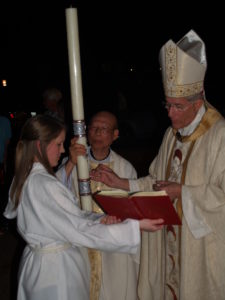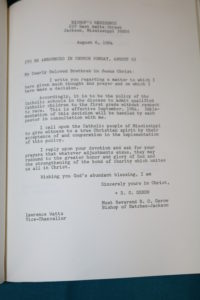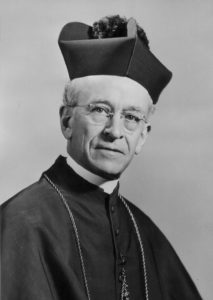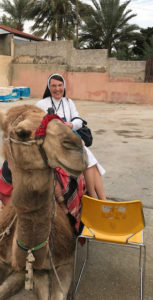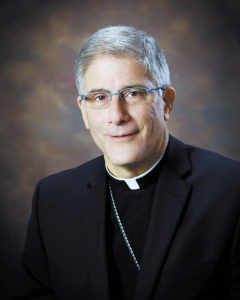
Obispo Joseph Kopacz
Por Obispo Joseph Kopacz
Una amplitud y profundidad de liturgias y fiestas marcaron los cuatro días de mi cuarta visita pastoral a la Misión San Miguel en Saltillo y a sus ranchos en lo alto del desierto con Mons. Mike Flannery. Era el fin de semana del domingo de la Divina Misericordia dentro de la octava de Pascua, un tiempo en que la Iglesia universal está alegremente encontrando al Señor crucificado y resucitado en la efusión de su amorosa compasión. Poco después de haber llegado el jueves por la tarde, celebré la Santa misa en la iglesia de la Divina Misericordia, la cual está funcionando desde su consagración hace dos años. La Novena de la Divina Misericordia, que comienza el viernes Santo, se observa durante toda la octava de Pascua, una semana que hace realidad lo que fue prometido durante la conmemoración de la Semana Santa con el Triduo Sacro. En efecto, nuestro Señor crucificado ha resucitado verdaderamente y su misericordia es eterna. Esta esperanza viva fue evidente en la devoción de los fieles, antes, durante y después de la misa, proporcionando un buen comienzo para la visita pastoral.
El maratón comenzó el viernes con nuestra partida a los ranchos a las 7 de la mañana. La primera de tres Misas de confirmación de ese día tuvo lugar en la Iglesia San Francisco a las 9 a.m. Fue alentador ver a los jóvenes con sus padres y padrinos en la iglesia vistiendo su atuendo formal, despiertos y deseosos de celebrar la confirmación. En la fiesta había una abundancia de comidas recién preparadas y sopa.
De allí salimos hacia el escabroso paisaje del desierto a visitar a las familias de cinco ranchos más para celebrar dos misas de confirmaciones y tres servicios cortos de oración. Como es costumbre, cuando la camioneta se acerca a cada rancho (comunidad) el conductor comienza a tocar la corneta por unos buenos cinco minutos para alertar a la gente que los misioneros han llegado. Al llegar a la iglesia tocan las campanas para dar la bienvenida a cualquier persona que no haya escuchado la corneta para reunirse para orar. Es estimulante el acompañar a estos dedicados sacerdotes, a los catequistas, a los choferes y a los jóvenes que trabajan en los diversos ministerios litúrgicos: servidores del altar, coro, lectores y sacristanes que viajan hacia los márgenes de la diócesis de Saltillo unas pocas veces cada semana. Esto no es una novedad para ellos.
Un día completo de viaje en el alto desierto del estado de Coahuila es una fascinante experiencia que penetra los huesos y la médula ósea. Aquí es donde los caminos no son caminos, sino apenas tramos navegables sobre largos senderos. Pero el paisaje del alto desierto es fascinante y cambiante. En algunas extensiones hay arbustos y cactus cuyas flores en abril ablandan sus defensas espinosas. Una especie de cactus luce un tono rojo que es encantador. Después de un tiempo el paisaje cambia y aparecen grandes árboles de palma con configuraciones creativas que en las sombras del anochecer o amanecer la imaginación podría ver fácilmente contorsiones amenazantes o entretenidas caricaturas. A veces en senderos estrechos uno puede ver en lo alto cordilleras sobresalientes o mirar hacia abajo y ver un terrorífico precipicio en cañón. Siempre había polvo, avivado por el constante trote de los neumáticos sobre superficies rocosas que no favorecieron la lectura o una siesta.
Sin embargo, con la misión siempre delante de nosotros, todo mereció la pena o, como uno dice en español, vale la pena. La prueba de resistencia del viernes terminó a las 8:30 p.m. en El Cuervo, un hotel de cacería situado en 10,000 acres de tierra, que es el hogar de una gran variedad de vida salvaje del desierto donde los cazadores vienen de todo México para probar sus habilidades en el desierto. Es realmente un hotel muy confortable, donde hemos sido tratados excepcionalmente bien por los propietarios durante los últimos tres años.
Dejamos El Cuervo bien temprano el sábado cuando estaba amaneciendo sobre el desierto para un recorrido de dos horas a la Capilla del Ejido la Brecha. Con el Obispo Raúl Vera, el Ordinario de Satillo, acompañándonos para celebrar la misa, bendecimos y colocamos la primera piedra, el primer paso para una nueva iglesia en el sitio. Nombrada por San José, modelo de los esposos, la fecha escogida para la consagración es el 1 de mayo de 2019, día de la fiesta de San José. Después de otra fiesta nos dirigimos a la Presa de San Pedro donde celebramos la confirmación con 24 candidatos, el mayor número en este año en curso. Al llegar a Saltillo por la tarde el Padre Mike y yo, junto con el Padre David y el Padre Evelio, dedicados sacerdotes de la Misión de San Miguel, tuvimos una agradable cena con el Obispo Raúl Vera.
En la mañana del domingo, la fiesta de la Divina Misericordia, nos quedamos en casa, por así decirlo, y celebramos dos misas festivas para este día de la Pascua de la misericordia. El agua fluyó en nuestra misa de las 9 a.m. con la renovación de las promesas bautismales, seguida del bautismo de siete niños después de la homilía. La celebración de la última confirmación enriqueció notablemente la misa de la 1 de la tarde, y el Obispo Vera, predicó y concelebró. Su profética homilía no será olvidada pronto por todos los asistentes, un apasionado llamado a ungir nuestras sociedades con el aceite mayor de justicia y paz. Descansado ahora y volviendo a pensar en inglés, recuerdo las últimas palabras del Evangelio de San Juan para el Domingo de la Divina Misericordia. “Estos signos de Jesús son grabados para que creáis que Jesús es el Mesías, el hijo de Dios, a fin de que creyendo, tengáis vida en su nombre.” La vida en su nombre abunda en la misión de Saltillo y nosotros, los fieles de Jackson y Biloxi, somos una parte importante de este camino de fe. Gracias a Dios.
Mañana es un día de descanso antes de viajar a Aguascalientes para la ordenación al diaconato de Adolfo Suárez-Pasillas en su parroquia natal. Un agradable cansancio se ha asentado en mí.


